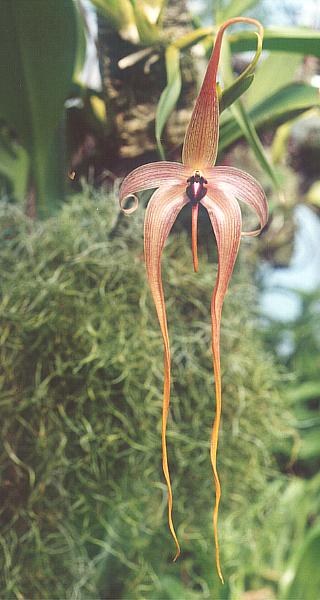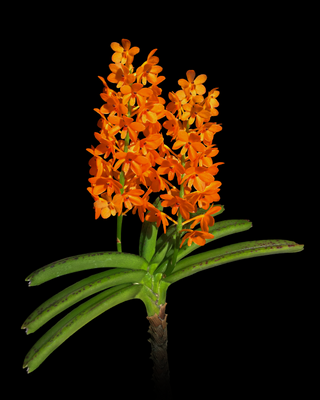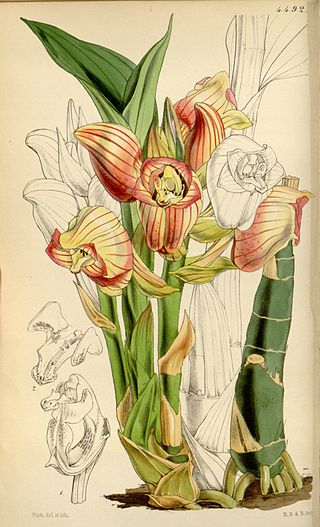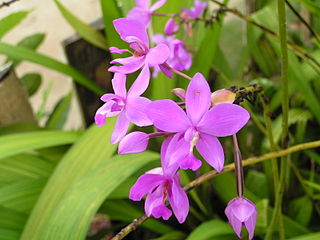
Orchids are plants that belong to the family Orchidaceae, a diverse and widespread group of flowering plants with blooms that are often colourful and fragrant.
A spa is a therapeutic water treatment. Related uses include:

Bulbophyllum is a genus of mostly epiphytic and lithophytic orchids in the family Orchidaceae. It is the largest genus in the orchid family and one of the largest genera of flowering plants with more than 2,000 species, exceeded in number only by Astragalus. These orchids are found in diverse habitats throughout most of the warmer parts of the world including Africa, southern Asia, Latin America, the West Indies, and various islands in the Indian and Pacific Oceans. Orchids in this genus have thread-like or fibrous roots that creep over the surface of trees or rocks or hang from branches. The stem is divided into a rhizome and a pseudobulb, a feature that distinguished this genus from Dendrobium. There is usually only a single leaf at the top of the pseudobulb and from one to many flowers are arranged along an unbranched flowering stem that arises from the base of the pseudobulb. Several attempts have been made to separate Bulbophyllum into smaller genera, but most have not been accepted by the World Checklist of Selected Plant Families.

A raceme or racemoid is an unbranched, indeterminate type of inflorescence bearing flowers having short floral stalks along the shoots that bear the flowers. The oldest flowers grow close to the base and new flowers are produced as the shoot grows in height, with no predetermined growth limit. Examples of racemes occur on mustard and radish plants.

Phalaenopsis, also known as moth orchids, is a genus of about seventy species of plants in the family Orchidaceae. Orchids in this genus are monopodial epiphytes or lithophytes with long, coarse roots, short, leafy stems and long-lasting, flat flowers arranged in a flowering stem that often branches near the end. Orchids in this genus are native to India, Taiwan, China, Southeast Asia, New Guinea and Australia with the majority in Indonesia and the Philippines.

In botany, the labellum is the part of the flower of an orchid or Canna, or other less-known genera, that serves to attract insects, which pollinate the flower, and acts as a landing platform for them.

Acanthophippium is a genus of orchid with thirteen species. The name of this genus is derived from the Greek words acanthos ("spiny") and ephippion ("saddle"), referring to the saddle-like labellum of the plants.

Spathoglottis, commonly known as purple orchids or 苞舌兰属 is a genus of about fifty species of orchids in the family Orchidaceae. They are evergreen terrestrial herbs with crowded pseudobulbs, a small number of leaves and medium-sized resupinate flowers on an upright flowering stem. The sepals and petals are all similar to each other and are white, yellow, pink or purple. Species of Spathoglottis are found from eastern and south-eastern Asia to Australia and some Pacific Islands.

Caladenia, commonly known as spider orchids, is a genus of 350 species of plants in the orchid family, Orchidaceae. Spider orchids are terrestrial herbs with a single hairy leaf and a hairy stem. The labellum is fringed or toothed in most species and there are small projections called calli on the labellum. The flowers have adaptations to attract particular species of insects for pollination. The genus is divided into three groups on the basis of flower shape, broadly, spider orchids, zebra orchids and cowslip orchids, although other common names are often used. Although they occur in other countries, most are Australian and 136 species occur in Western Australia, making it the most species-rich orchid genus in that state.

Cephalantheropsis is a genus of orchids, comprising 4 accepted species distributed in China, Japan, the Eastern Himalayas and Southeast Asia.

Thelymitra, commonly known as sun orchids, is a genus of more than 100 species of plants in the orchid family, Orchidaceae. Unlike most other orchids, sun orchids lack a highly modified labellum and all three petals are similar in size, shape and colour. The column is, however, highly modified and usually has prominent wings or glands which are helpful in identifying the species. Most sun orchids close their flowers at night, in cloudy or cool weather, giving rise to their common name. The scientific name means "woman's hood" and refers to the hooded column present in most, but not all species. Most species are endemic to Australia although some are found as far from there as the Philippines and Indonesia. The type species, Thelymitra longifolia, the first to be formally described, was collected in New Zealand.

Chliaria othona, the orchid tit, is a species of lycaenid or blue butterfly found in Asia.

Hypolycaena nilgirica, the Nilgiri tit, is an uncommon species of lycaenid or blue butterfly found in Asia, especially in the lowland regions to mid-hills of India and Sri Lanka.

Spathoglottis affinis is a species of orchid found from Indochina to western Malesia.

Spathoglottis plicata, commonly known as the Philippine ground orchid, or large purple orchid is an evergreen, terrestrial plant with crowded pseudobulbs, three or four large, pleated leaves and up to forty resupinate, pink to purple flowers. It is found from tropical and subtropical Asia to Australia and the western Pacific including Tonga and Samoa.

Spathoglottis pubescens is a species of terrestrial orchid found from Arunachal Pradesh in India to southern China and Indochina.
Pidaung Wildlife Sanctuary is a protected area in Myanmar's Kachin State, covering 122.07 km2 (47.13 sq mi) at an elevation of 155–665 m (509–2,182 ft) in Myitkyina Township.

Spathoglottis paulinae, commonly known as the small purple orchid, is a plant in the orchid family and is native to New Guinea and Tropical North Queensland. It is an evergreen terrestrial orchid with crowded pseudobulbs, between four and seven large, pleated leaves and up to thirty mauve to purple flowers.
















